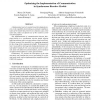Free Online Productivity Tools
i2Speak
i2Symbol
i2OCR
iTex2Img
iWeb2Print
iWeb2Shot
i2Type
iPdf2Split
iPdf2Merge
i2Bopomofo
i2Arabic
i2Style
i2Image
i2PDF
iLatex2Rtf
Sci2ools
RTAS
2008
IEEE
2008
IEEE
Optimizing the Implementation of Communication in Synchronous Reactive Models
A fundamental asset of a model-based development process is the capability of providing an automatic implementation of the model that preserves its semantics and, at the same time, makes an efficient use of the resources of the execution platform. The implementation of communication between functional blocks in a synchronous reactive model requires buffering schemes and access procedures at the kernel level. Previous research has provided two competing proposals for the sizing of the communication buffer. We demonstrate how it is possible to leverage task timing information to obtain tighter bounds for the case of sporadic tasks or periodic tasks with unknown activation phase, and we propose an approach that applies to a more general model. Furthermore, we provide the description of the data structures and constant-time access procedures for writer and reader tasks, and an implementation compliant with the OSEK OS standard.
Access Procedures | Model-based Development Process | Real-Time Technology | RTAS 2008 | Synchronous Reactive Model |
| Added | 01 Jun 2010 |
| Updated | 01 Jun 2010 |
| Type | Conference |
| Year | 2008 |
| Where | RTAS |
| Authors | Marco Di Natale, Guoqiang Wang, Alberto L. Sangiovanni-Vincentelli |
Comments (0)

